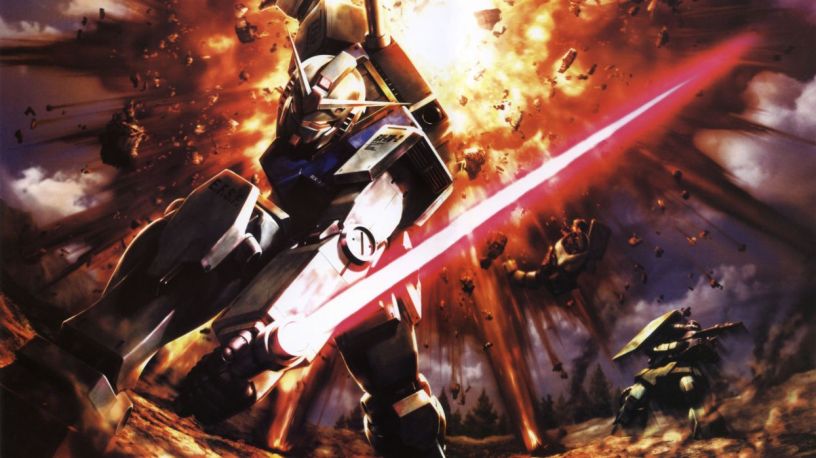After my Atelier and LEGO articles, I wanted to continue writing about franchises which have had a major presence across both Vita and PSP. There were a number of names which came up, but none more so than Gundam – the long running mech-anime series that has remained supremely popular in Japan for more than 30 years and has made inroads into the western market recently.
It’s a franchise that’s become so big in gaming that it has spawned multiple sub-series within the brand – you can get everything from action games (Battle); to brawler (Warriors); to fighting (Versus) to strategy (SD Gundam), each one providing a different experience yet incorporating the titular mobile suits in unique ways. Vita has benefited from this wide genre variety and has been home to some cracking titles, with even more available through backwards-compatibility if you have a Japanese account.
So in this article I’ll be looking back at a history of the franchise on Sony’s handhelds from its origins on the PSP right through the latest release on Vita, with an emphasis on the quality of the ports to the handhelds as well as any sales figures that are available; alongside a conclusion of how well the franchise has done on the console.
A new type of handheld and a new type of Gundam
The PSP represented a paradigm shift in terms of handheld hardware, capable of emulating arcade and home console experiences like never before. The Gundam franchise benefited massively from this – while it had made appearances across the Gameboy; Gameboy Advance; Game Gear; Wonderswan and Wonderswan Colour, it was able to tackle new genres and ideas on the PSP which went down incredibly well with consumers.
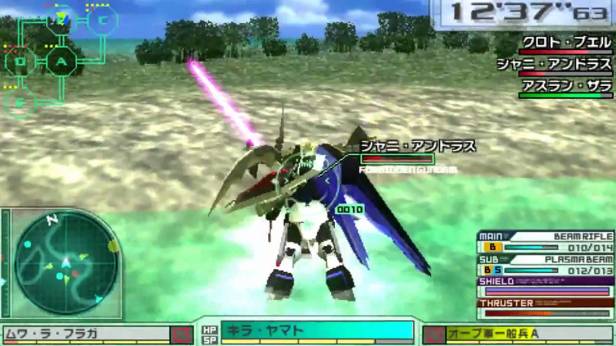 No games better demonstrate this than the Gundam Battle sub-series, developed by Artdink and debuting with Gundam Battle Tactics in 2005. Rather than the strategy gameplay seen in previous handheld entries, these games featured an action focus and had a series of short missions with the aim of grinding through to obtain better ranks to unlock new content. Four sequels released between 2006 and 2010 – Gundam Battle Royale; Gundam Battle Chronicle; Gundam Battle Universe and Gundam Assault Survive, each one refining the formula slightly while adding new elements.
No games better demonstrate this than the Gundam Battle sub-series, developed by Artdink and debuting with Gundam Battle Tactics in 2005. Rather than the strategy gameplay seen in previous handheld entries, these games featured an action focus and had a series of short missions with the aim of grinding through to obtain better ranks to unlock new content. Four sequels released between 2006 and 2010 – Gundam Battle Royale; Gundam Battle Chronicle; Gundam Battle Universe and Gundam Assault Survive, each one refining the formula slightly while adding new elements.
Indeed, these wouldn’t be the only action-based Gundam games developed for PSP. Level-5 were handed the reigns to the franchise in 2010 and developed a double release based on Mobile Suit Gundam AGE (Cosmic Drive & Universal Accel) that provided building and battling with mobile suits alongside the storyline of the anime (and would form the basis of the company’s future series Little Battlers), although commercial reception was tepid as the games only sold around 50k between them. 2010 would also see the release of Gundam Memories: Tatakai no Kioku, a hack ‘n’ slash meets third-person shooter; while 2009 got a very interesting arcade to PSP port in Mobile Suit Gundam: Senjou no Kizuna, a portable version of the VR-pod based shooter that somehow managed to keep the core experience in tact.
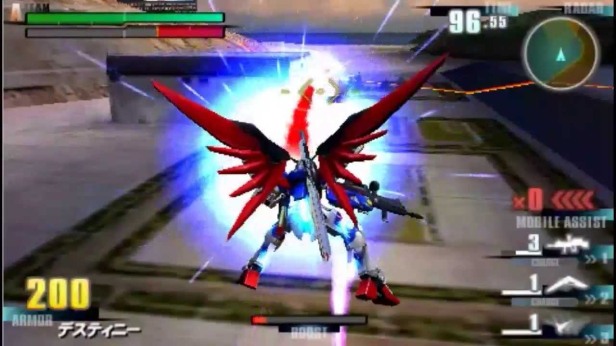 However, arguably the biggest success of the series on Sony’s handheld was the Gundam Vs. sub-series which made its debut on PSP in 2007 with Mobile Suit Gundam SEED: Federation vs. ZAFT Portable – a down-port of a PS2 game which itself was translated from arcades. Rather than the mission-based modes found in other titles, Vs focused on 1 v 1 or 2 v 2 arena battles with a fighting game base, seemingly heavily inspired by SEGA’s Virtual-On franchise. It would prove to be a successful formula that Bandai-Namco kept iterating on for years to come, including on PSP which received two more entries in Gundam vs Gundam and Gundam vs Gundam: Next – which became the highest selling Gundam games in the franchise on handheld with both clearing 400k.
However, arguably the biggest success of the series on Sony’s handheld was the Gundam Vs. sub-series which made its debut on PSP in 2007 with Mobile Suit Gundam SEED: Federation vs. ZAFT Portable – a down-port of a PS2 game which itself was translated from arcades. Rather than the mission-based modes found in other titles, Vs focused on 1 v 1 or 2 v 2 arena battles with a fighting game base, seemingly heavily inspired by SEGA’s Virtual-On franchise. It would prove to be a successful formula that Bandai-Namco kept iterating on for years to come, including on PSP which received two more entries in Gundam vs Gundam and Gundam vs Gundam: Next – which became the highest selling Gundam games in the franchise on handheld with both clearing 400k.
Continued success of classic sub-series
Of course, while it proved to be a great opportunity for new portable Gundam experiences, PSP also housed some of Bandai-Namco’s longest running sub-series too – making it a versatile machine for fans of the franchise.
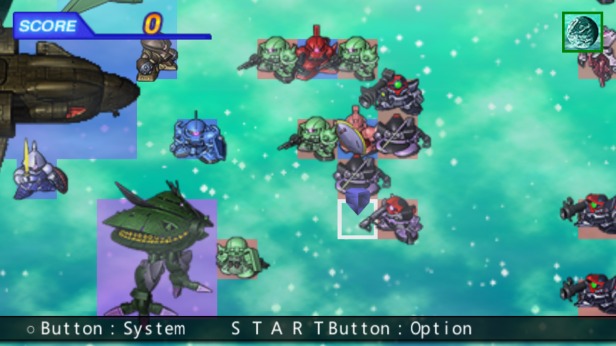 Perhaps the biggest of these was SD Gundam G Generation – a strategy-RPG series featuring super deformed versions of the mobile suits battling it out across turn-based grids that had been hugely popular on the original PlayStation. Sony’s handheld received three entries – the first, G Generation Portable, was a remake of a PS1 entry while subsequent releases World and Overworld featured new storylines and content that spanned the breadth of the Gundam IP in the modern era. They were big sellers, with World clearing 300k whilst Portable and Overworld hit the 250k mark in Japan.
Perhaps the biggest of these was SD Gundam G Generation – a strategy-RPG series featuring super deformed versions of the mobile suits battling it out across turn-based grids that had been hugely popular on the original PlayStation. Sony’s handheld received three entries – the first, G Generation Portable, was a remake of a PS1 entry while subsequent releases World and Overworld featured new storylines and content that spanned the breadth of the Gundam IP in the modern era. They were big sellers, with World clearing 300k whilst Portable and Overworld hit the 250k mark in Japan.
The mobile suits also made appearances in another of Bandai-Namco’s popular SRPG franchises entitled Super Robot Wars – a crossover mech series featuring robots from a number of different anime/manga series. Their biggest success on PSP was undoubtedly the two-part release Super Robot Wars Z II that debuted in 2011 with Hakai-Hen before 2012’s Saisen-Hen became available – the former sold over 400k in Japan while the latter shifted 300k and undoubtedly the Gundam attachment was a big part of their draw. PSP also received two remakes of Super Robot Wars A and Super Robot Wars MX, as well as the original storyline title Masou Kishin II.
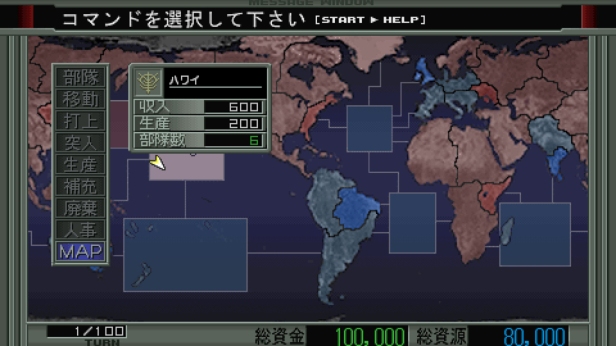 Beyond this, Bandai-Namco experimented with other types of Gundam strategy game on PSP with somewhat mixed results. Three games subtitled Giren no Yabou were released (a sub-series which originally started on the SEGA Saturn) that took the turn-based gameplay of SD Gundam and laid it on the management formula of Nobunaga’s Ambition; while Mobile Suit Gundam: Mokuba no Kiseki was a real-time strategy title which retraced the events of the one-year war and released to mild sales of around 28k.
Beyond this, Bandai-Namco experimented with other types of Gundam strategy game on PSP with somewhat mixed results. Three games subtitled Giren no Yabou were released (a sub-series which originally started on the SEGA Saturn) that took the turn-based gameplay of SD Gundam and laid it on the management formula of Nobunaga’s Ambition; while Mobile Suit Gundam: Mokuba no Kiseki was a real-time strategy title which retraced the events of the one-year war and released to mild sales of around 28k.
PSP had clearly been a fantastic home for Gundam, but by the January 2012 release of Mokuba no Kiseki (aka Mobile Suit Gundam: Path of the Trojan Horse), a new Sony console was available – that would quickly take up the mantle previously held by PSP and bring all new Gundam experiences to handhelds, with a few familiar re-appearances along the way.
A shift in hardware with old series and new surprises
With the December 2011 release of the PlayStation Vita, a natural successor for high-end handheld Gundam games was born. While it was Bandai-Namco’s initial idea to carry on their successful PSP sub-series with new bells and whistles, they also brought both previously home console-only sub-series as well as brand new ideas to the console – making Vita a great place to be a fan of the IP in its early years.
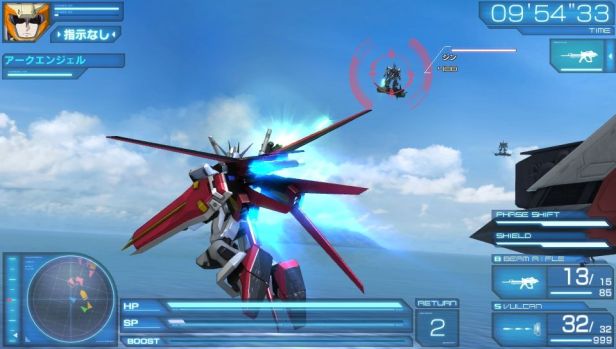 Their first release came in June 2012 (a mere 6 months after the handheld’s launch) as Mobile Suit Gundam: SEED Battle Destiny. Unsurprisingly, it was the latest in Artdink’s successful Battle sub-series that was last seen on PSP as Assault Survive in 2010 (in fact, it’s likely that SEED Battle Destiny was supposed to be the 2011 entry for PSP that got delayed for the new handheld). This time, the game focused on the ‘cosmic era’ and featured suits and characters from that timeline, as well as a story mode which allowed players to tackle the events of Gundam SEED and SEED Destiny.
Their first release came in June 2012 (a mere 6 months after the handheld’s launch) as Mobile Suit Gundam: SEED Battle Destiny. Unsurprisingly, it was the latest in Artdink’s successful Battle sub-series that was last seen on PSP as Assault Survive in 2010 (in fact, it’s likely that SEED Battle Destiny was supposed to be the 2011 entry for PSP that got delayed for the new handheld). This time, the game focused on the ‘cosmic era’ and featured suits and characters from that timeline, as well as a story mode which allowed players to tackle the events of Gundam SEED and SEED Destiny.
It was an early highlight in the console’s Japanese library; saw moderate sales success (IGN noted that the 40k it shifted in its first week was a good result for a Vita game at the time) and was a popular title among importers, but unfortunately it also marked the end of the Gundam Battle sub-series, as neither Vita nor any other console received any more entries after this. Artdink would re-use the engine and many of the mechanics for Macross Delta Scramble in 2016 (much the same as they’d done on PSP between the two franchises), but otherwise SEED Battle Destiny was effectively the last of its kind.
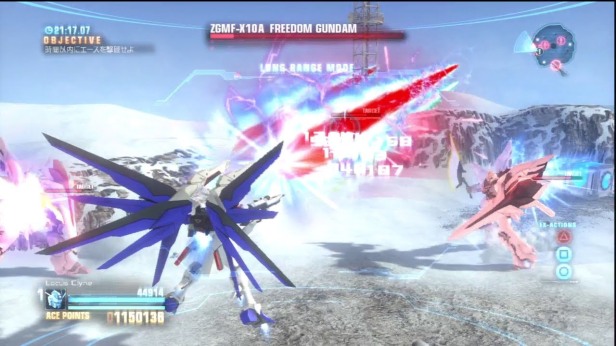 It would be a long wait until October 2013 for the next Gundam game, but thankfully this was well worth it as Bandai-Namco delivered something surprisingly different in Breaker – a third-person shooter/brawler with a loot mechanic that let you build your own suits with the parts you collect. The title originally released for PS3 in the summer of 2013 and with the delay, the Vita version launched with extra content and a limited edition console, which provided a minor sales boost that week. The game was fairly well received (I quite enjoyed it) and would quickly become an important new sub-series for the company going forward.
It would be a long wait until October 2013 for the next Gundam game, but thankfully this was well worth it as Bandai-Namco delivered something surprisingly different in Breaker – a third-person shooter/brawler with a loot mechanic that let you build your own suits with the parts you collect. The title originally released for PS3 in the summer of 2013 and with the delay, the Vita version launched with extra content and a limited edition console, which provided a minor sales boost that week. The game was fairly well received (I quite enjoyed it) and would quickly become an important new sub-series for the company going forward.
The year would be capped off by something equally surprising – Dynasty Warriors Gundam Reborn, a reboot of the successful musou-crossover series. The previous three entries had all landed on home consoles and Reborn marked the first handheld entry – which clearly resonated well with the market as the game sold well over the holiday period, eventually shifting more than 120k copies on Vita alone in Japan. Unfortunately, while the game did eventually come west this was only for PS3 – Vita was unceremoniously skipped, a common trait among Bandai-Namco games at the time.
 Within two years of being on the market, Sony’s new handheld had shown itself to be a suitable home for the Gundam franchise with multiple new titles selling respectable amounts. There were omens to what the future would hold though – Vita hadn’t quite inherited PSP’s mantle and exclusive entries were quickly becoming a thing of the past as multi-platform development became the name of the game.
Within two years of being on the market, Sony’s new handheld had shown itself to be a suitable home for the Gundam franchise with multiple new titles selling respectable amounts. There were omens to what the future would hold though – Vita hadn’t quite inherited PSP’s mantle and exclusive entries were quickly becoming a thing of the past as multi-platform development became the name of the game.
New genres; new monetization; same great Gundam
With three successful Vita Gundam games under their belt, Bandai-Namco sought to expand their portfolio on the handheld with new ideas and genres in the following years – which saw mixed success, but thankfully the majority of the titles released were fun.
 2014 started with the release of 3rd Super Robot Wars Z: Jigoku-Hen in April – the final entry in the long running Super Robot Wars Z series which was delivered over two parts just as with its PSP predecessor (a sequel, Tengoku-Hen released a year later in 2015). The crossover mech strategy-RPG series had always relied heavily on Gundam suits to fill out its roster and these entries were no different – again, Vita proved to be a solid home with the titles selling 180k and 160k respectively, going toe-to-toe with the PS3 version in sales.
2014 started with the release of 3rd Super Robot Wars Z: Jigoku-Hen in April – the final entry in the long running Super Robot Wars Z series which was delivered over two parts just as with its PSP predecessor (a sequel, Tengoku-Hen released a year later in 2015). The crossover mech strategy-RPG series had always relied heavily on Gundam suits to fill out its roster and these entries were no different – again, Vita proved to be a solid home with the titles selling 180k and 160k respectively, going toe-to-toe with the PS3 version in sales.
In fact, these weren’t the only Gundam SRPG crossovers to arrive in this timeframe either. Super Robot Wars OG Saga Masou Kishin III: Pride of Justice (quite a naming mouthful at this point) released in late 2013, again featuring Gundam mechs in a supporting role (as with the 2012 PSP prequel Masou Kishin II); while Super Hero Generation was a crossover of Gundam; Kamen Rider and Ultraman which landed in late 2014. Neither were particularly successful, although this did little to slow down the franchise on Vita which was now in full swing.
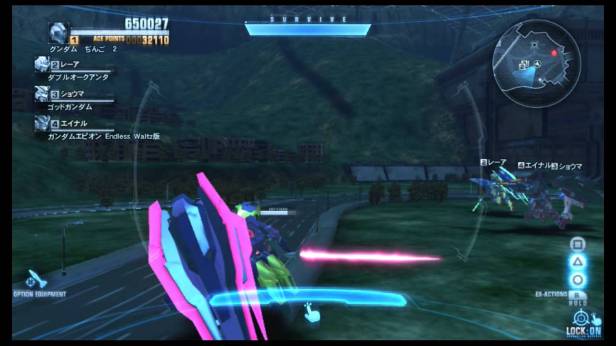 Buoyed by the obvious success of the first game in 2013, a sequel to Gundam Breaker was very much on Bandai-Namco’s mind which released in Japan in December of 2014 simultaneously across PS3 and Vita and was a massive improvement over the first title, adding a proper storyline while making notable quality-of-life changes to the gameplay. It seems this resonated well with consumers as the title went on to be Vita’s highest selling Gundam game at that point, clearing 140k domestically.
Buoyed by the obvious success of the first game in 2013, a sequel to Gundam Breaker was very much on Bandai-Namco’s mind which released in Japan in December of 2014 simultaneously across PS3 and Vita and was a massive improvement over the first title, adding a proper storyline while making notable quality-of-life changes to the gameplay. It seems this resonated well with consumers as the title went on to be Vita’s highest selling Gundam game at that point, clearing 140k domestically.
Moving into 2015, the IP was expanding onto new horizons – on mobile, a number of free-to-play titles were available and it didn’t take long for these to dabble in the Vita market either. Gundam Conquest V was a strategy/simulation game originally based on a mobile release while Mobile Suit Gundam: Battle Fortress was a real-time strategy designed specifically for the hardware. Given both stopped their service within a year, it seems this gamble didn’t quite pay off (in fact very few F2P titles have managed to find success on Vita aside from Phantasy Star Online 2), but the titles marked the first venture into unique genres on Sony’s handheld line since 2012’s Path of the Trojan Horse on PSP.
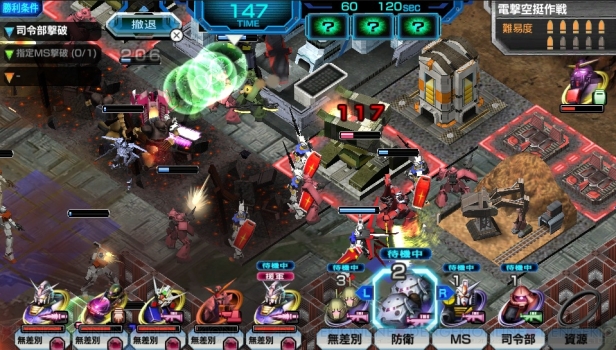 At this point, Gundam was well integrated in the Vita’s software ecosystem and seemed like it was here to stay – just like it had been on the handheld’s predecessor. While the IP would see its biggest ever domestic sales ever on Vita at the end of 2015, it also marked the beginnings of an expansion into the overseas market for the first time in nearly a decade.
At this point, Gundam was well integrated in the Vita’s software ecosystem and seemed like it was here to stay – just like it had been on the handheld’s predecessor. While the IP would see its biggest ever domestic sales ever on Vita at the end of 2015, it also marked the beginnings of an expansion into the overseas market for the first time in nearly a decade.
Overseas expansion and continued success
It had been a long time coming, but in December 2015 Bandai-Namco finally released a Gundam Vs. game on Vita – although it wasn’t quite the title fans had been hoping for all this time after the brilliant Gundam vs. Gundam PSP releases.
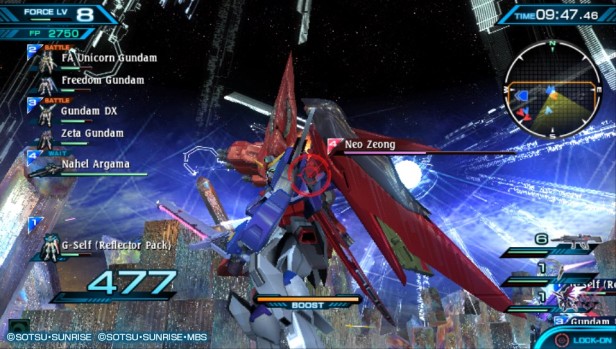 The game was revealed at TGS 2015 as Mobile Suit Gundam: Extreme Vs. Force and promised to bring all the arena-based combat of the arcade titles to handheld while adding in a new attack/defend ‘force’ mode. Personally I loved it although Japanese fans were decidedly less kind – criticising the small roster (less than PSP entries); lack of ‘free battle’ mode at launch and 30fps lock meaning combat felt less fluid.
The game was revealed at TGS 2015 as Mobile Suit Gundam: Extreme Vs. Force and promised to bring all the arena-based combat of the arcade titles to handheld while adding in a new attack/defend ‘force’ mode. Personally I loved it although Japanese fans were decidedly less kind – criticising the small roster (less than PSP entries); lack of ‘free battle’ mode at launch and 30fps lock meaning combat felt less fluid.
This didn’t seem to affect initial sales – the game launched to an impressive 87k in Japan, but as copies were quickly returned the game hit bargain bins and only managed to shift 170k copies as of the end of 2016 – making it the best selling Gundam title on Vita in Japan, but far below its potential (especially compared to the 400k the sub-series was clearing on PSP). Perhaps to combat this drop-off in domestic sales, Extreme Vs Force became the first non-Warriors Gundam game to see an overseas release since Crossfire on the PS3 in 2007 – hitting western shores as a digital-only title in July and sporting an Asian-English physical copy to boot.
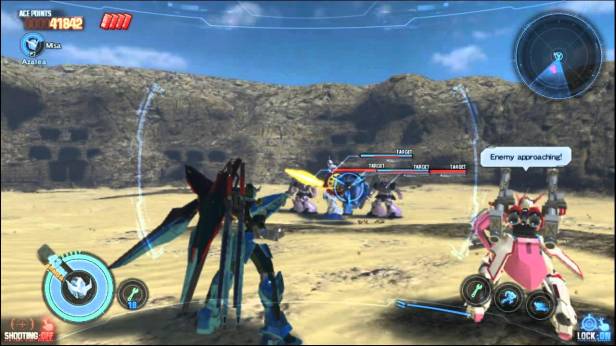 Thankfully, this wasn’t an isolated incident and Bandai-Namco quickly followed this up with Gundam Breaker 3 – the latest in their now-regular sub-series. While Japanese sales were slightly down on its predecessor (owing somewhat to the PS3 -> PS4 transition), the company made up for this by offering an Asian-English version almost concurrently – although oddly there was no western release, suggesting the IP still had issues with licensing. The Vita version itself was a mixed bag – it didn’t run as well as Breaker 2, suggesting less time was now being devoted to handheld ports as the company further transitioned towards PS4, but still offered the most complete handheld Breaker experience available.
Thankfully, this wasn’t an isolated incident and Bandai-Namco quickly followed this up with Gundam Breaker 3 – the latest in their now-regular sub-series. While Japanese sales were slightly down on its predecessor (owing somewhat to the PS3 -> PS4 transition), the company made up for this by offering an Asian-English version almost concurrently – although oddly there was no western release, suggesting the IP still had issues with licensing. The Vita version itself was a mixed bag – it didn’t run as well as Breaker 2, suggesting less time was now being devoted to handheld ports as the company further transitioned towards PS4, but still offered the most complete handheld Breaker experience available.
Breaker 3 would be the last ‘action’ Gundam game available on Vita – all future releases would be strategy-RPG’s, starting with SD Gundam G Generation Genesis in November of 2016. The first new entry in the sub-series since Over World on PSP in 2012 gained notoriety for being the first (and currently only) Vita title to use two cartridges – a novelty that was expended to the Asian-English release that quickly followed. Japanese reception and sales were positive, although the game didn’t quite reach the commercial highs of its predecessors on PSP (at least in the domestic market, where it sold around 115k on Vita).
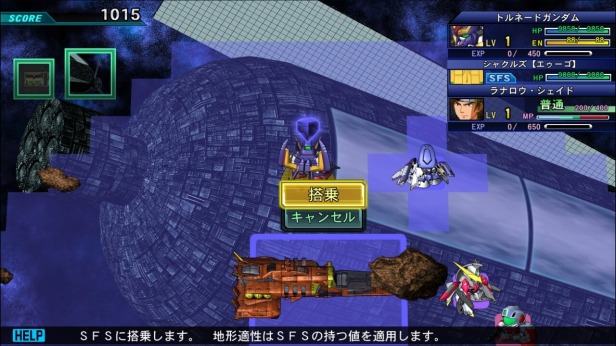 Heading into 2017, the only Gundam representation came in the form of Super Robot Wars – the crossover mech franchise that had seen numerous entries across PSP and Vita. A brand new title – V – launched simultaneously across PS4 and Vita in March and brought with it updated sprites, new missions with the same great strategic gameplay. Sales were down compared to the 3rd Super Robot Wars Z duology, but not enough to be a worry to Bandai-Namco and with the Vita version still pulling its weight, it seemed the franchise still had a future on the handheld even at this late stage.
Heading into 2017, the only Gundam representation came in the form of Super Robot Wars – the crossover mech franchise that had seen numerous entries across PSP and Vita. A brand new title – V – launched simultaneously across PS4 and Vita in March and brought with it updated sprites, new missions with the same great strategic gameplay. Sales were down compared to the 3rd Super Robot Wars Z duology, but not enough to be a worry to Bandai-Namco and with the Vita version still pulling its weight, it seemed the franchise still had a future on the handheld even at this late stage.
Future Gundam games on Vita
As of the date of writing, the only upcoming Gundam game scheduled for release on Vita is Super Robot Wars X – an asset-reuse sequel to V that’s scheduled to release in just a few short weeks. Even though Gundam Vita support appears to now be ending, this still makes it one of the best performers among Bandai-Namco’s roster of anime franchises, as it has outlasted many similar series on the handheld such as One Piece or Sword Art Online.
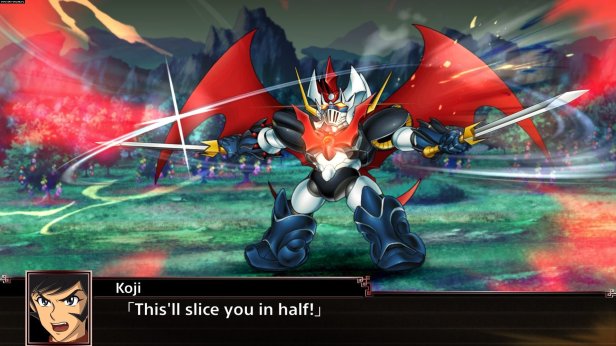 It seems pretty clear that this will be the final Gundam representation on the console – both Breaker and Versus have shifted to being PS4-only (New Gundam Breaker and Gundam Versus respectively), while SD Gundam G Generation Genesis is getting a late port on Nintendo Switch suggesting its future lies on Nintendo’s newest offering. Meanwhile, Gundam Musou seems to have disappeared again while Artdink have been pulled off the franchise altogether – both of which are extremely disappointing considering they produced arguably the best entry in recent memory.
It seems pretty clear that this will be the final Gundam representation on the console – both Breaker and Versus have shifted to being PS4-only (New Gundam Breaker and Gundam Versus respectively), while SD Gundam G Generation Genesis is getting a late port on Nintendo Switch suggesting its future lies on Nintendo’s newest offering. Meanwhile, Gundam Musou seems to have disappeared again while Artdink have been pulled off the franchise altogether – both of which are extremely disappointing considering they produced arguably the best entry in recent memory.
Conclusion
PSP had provided a brilliant new platform to deliver Gundam content for Bandai-Namco and they experimented with everything from action games to strategy-simulations, nearly all of which was met with resounding success. Comparatively, they seemed less keen on Vita and aside from a few odd exceptions only treated it as a handheld extension of their home console strategy, a stark difference from their bespoke PSP experiences.
In spite of this, the Vita proved to be a more than capable home for nearly everything they were willing to throw at it – often outselling its PS3 and PS4 counterparts domestically. The series went from strength-to-strength on the platform over the course of five years despite some questionable efforts in the later years damaging the brand’s sales potential, which is a shame given how much care was put into early Gundam products like SEED Battle Destiny and Dynasty Warriors Gundam Reborn.
Bandai-Namco have now pretty much fully transitioned to PS4 – which always seemed like their ultimate goal – aside from a few asset-reuse remnants of their former strategy. Still, while the Vita proved to be a fitting home for the IP, the Gundam games also provided a fantastic addition to the handheld’s library with some of the most under-rated and enjoyable titles available on it featuring the long-running mech series. And for that I’m very thankful – the Breaker games, Extreme Vs Force and SEED Battle Destiny will ensure that my Vita will stay well-used for many years in the future.
